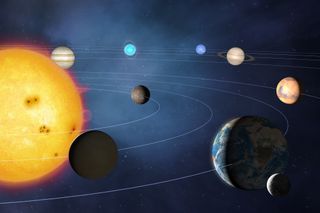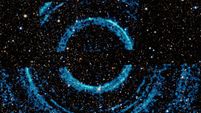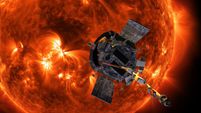What does the edge of the solar system look like?
- Get link
- X
- Other Apps
By Randyn Bartholomew - Live Science Contributor
It's weirder than you may have imagined.

Earth is the sixth planet from the edge of the solar system, meaning we're none too near this cold and inhospitable frontier. But we've sent out various spacecraft over the years, so do we have any idea what the edge of the solar system looks like?
The answer is yes, but it's a work in progress. One of the latest developments, a 3D map of the solar system's edge that took 13 years to create, revealed a few more secrets about this mysterious boundary, called the outer heliosphere.
The outer heliosphere marks the region of space where the solar wind, or the stream of charged particles emitted from the sun, is "deflected and draped back" by the interstellar radiation that permeates the empty space beyond the solar system, said Dan Reisenfeld, a space science researcher at Los Alamos National Laboratory in New Mexico and head of the team that conducted the research on the 3D map. In other words, solar wind and interstellar particles meet and form a boundary at the far reaches of the solar system.
Related: What happens in intergalactic space?
Earthlings first got a glimpse of the solar system's outer edge in 2012, when Voyager I, a NASA spacecraft that launched in 1977, crossed into interstellar space, according to NASA. Voyager 2 was not far behind, repeating the feat in 2018. Equipped with golden records full of Bach, Louis Armstrong and humpback whale songs, in addition to their scientific instruments, Voyagers 1 and 2 reported a sudden dropoff in solar particles and a substantial increase in galactic radiation when they left the solar system, according to NASA's Jet Propulsion Laboratory at the California Institute of Technology.
The new 3D map reveals even more about the heliosphere. The inner layer — where the sun and its planets are nestled — is roughly spherical and is thought to extend roughly 90 astronomical units (AU) in all directions. (One AU is the average distance between Earth and the sun, about 93 million miles, or 150 million kilometers.) The outer layer is much less symmetrical. In one direction — that in which the ever-moving sun plows through the space in front of it, encountering cosmic radiation — the outer heliosphere extends about 110 AU, but in the opposite direction, it's much longer, at least 350 AU, according to Reisenfeld.

That lack of symmetry comes from the sun's movement through the Milky Way, as it experiences friction with the galactic radiation in front of it and clears out a space in its wake. "There's a lot of plasma [charged particles] in the interstellar medium, and… the inner heliosphere, which is pretty round, is an obstacle in this stream of plasma which is flowing past it," Reisenfeld told Live Science. "It has the same effect as water going around a rock in a stream," with a rush of water crashing into the rock in front and a sheltered calm behind it.
Measurements for the 3D map were gathered using the Interstellar Boundary Explorer (IBEX), which was launched in 2008 and is "the size of a bus tire," according to NASA. It's pronounced "like the animal," Reisenfeld said, referring to the ibex mountain goats known for their gravity-defying treks up alpine cliffs. But the animal that IBEX really takes after is the bat.
Many bats hunt insects, such as mosquitoes, by emitting a pulse of sound and using the time delay of the echo to figure out the distance to their prey. Likewise, IBEX detects solar-wind particles that have bounced back from the edges of the solar system, allowing Reisenfeld and his colleagues to determine the distances involved by measuring how long their round trip took. "The sun will send out a pulse … and then we passively wait for a return signal from the outer heliosphere, and we use that time delay to determine where the outer heliosphere must be," Reisenfeld explained.
As the sun circles the outer rim of the Milky Way, the solar wind keeps cosmic radiation at bay, forming a protective bubble. This is good for us, since "that radiation can damage spacecraft and it can be a health hazard for astronauts," Reisenfeld said.
However, the boundaries may not stay this way in the long term. Reisenfeld noted that there is a correlation between the strength of the solar wind and the number of spots on the sun. A sunspot is a relatively dark patch that temporarily appears on the surface of the sun as a result of intense magnetic disturbances within. From 1645 to 1715, a period known to sun watchers as the Maunder minimum, there were very few sunspots, and thus there may have been only weak solar winds.
"The sunspots disappeared for almost a century, and if that happens, the shape of the heliosphere could have also changed significantly," Reisenfeld said. "We do see variations in solar activity, and at any time, another Maunder minimum could happen. It's not a pie-in-the-sky concern to be worried that the [heliosphere’s] effectiveness at shielding could change over time."
To learn more about the heliosphere, NASA plans to launch a new mission called the Interstellar Mapping and Acceleration Probe (IMAP) in 2025. If all goes according to plan, IMAP will reveal further details about interactions between solar winds and cosmic radiation at the solar system's edge.
Originally published on Live Science.



Comments
Post a Comment